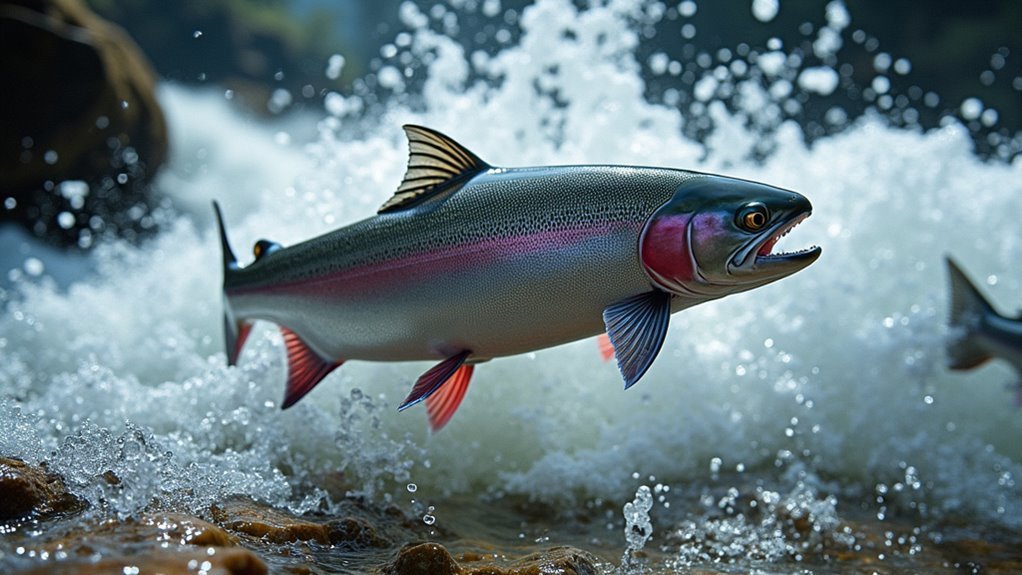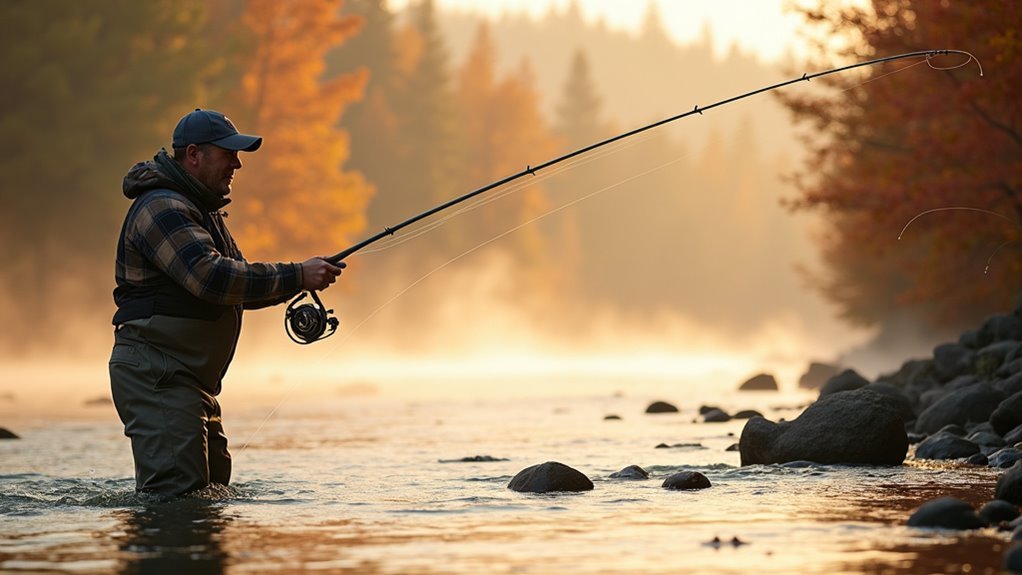To master steelhead fishing, you’ll need to understand their migration patterns and habitat preferences. Look for rocky, gravelly stretches with moderate depth and current breaks near boulders where these powerful fish hold. Adapt your approach seasonally—use faster presentations for summer-run fish and slower drifts for winter steelhead. Match your gear to conditions with an 8-9 foot rod and 8-12 pound fluorocarbon line. The most successful anglers know when to adjust their tactics as water temperatures and clarity change.
Understanding Steelhead Behavior and Migration Patterns

While most anglers focus on the where and when of steelhead fishing, truly understanding the behavior and migration patterns of these magnificent fish can dramatically increase your success on the water.
They’re not just randomly swimming—they’re following instinctual paths shaped by millions of years of evolution.
Steelhead move with purpose, shifting from ocean to river and back again. They prefer rocky, gravelly stretches with moderate depth and current, often holding near boulders where they can rest.
These magnificent fish follow ancient, purposeful journeys, seeking sanctuary in gravelly runs and behind river stones between their saltwater adventures.
I think their color changes—silvery in ocean, vibrant in freshwater—tell you something about their incredible adaptability.
Essential Gear Selection for Successful Steelhead Angling
Because choosing the right gear can make or break your steelhead fishing experience, you’ll want to invest time in selecting equipment that matches both the conditions and your fishing style.
I think an 8-9 foot rod offers that perfect balance between control and casting distance from the bank.
For line, quality fluorocarbon in the 8-12 pound range works well, though I’ve had good days with monofilament leaders too.
Your reel should have a smooth drag system—perhaps more important than people realize when fighting these powerful fish.
Don’t forget waders! You’ll need sturdy ones as you’ll often navigate rocky, sometimes slippery terrain.
Reading River Water: Identifying Prime Steelhead Holding Areas
Once you’ve got your gear ready, spotting where steelhead actually hide is what truly separates successful anglers from those going home empty-handed.
I think the key is understanding that steelhead are creatures of habit and comfort.
Look for rocky, gravelly sections with moderate depth and current breaks. Steelhead often hold behind boulders where they can rest while staying close to food-carrying currents.
Steelhead seek sanctuary in the dance between rest and nourishment, using boulders as their staging grounds.
Tailwaters just below pools are particularly productive spots in winter, though you’ll need some stealth approaching these areas.
Perhaps the most overlooked spots are change zones between fast riffles and slower pools – these gathering areas are where I’ve had my most memorable catches.
Seasonal Tactics: Adapting Your Approach Throughout the Year

As the seasons shift throughout the year, so must your steelhead tactics if you’re hoping for consistent success.
Summer-run fish (March through early summer) often respond well to faster presentations and brighter colors, while the larger winter-run steelhead typically prefer slower drifts.
I think water temperature is perhaps the most essential factor.
When it’s cold—below 40°F—you’ll need to slow everything down and fish deeper pools. In warmer conditions, don’t hesitate to cover more water with spinners or spoons.
Most Effective Bait and Lure Strategies for Stubborn Steelhead
When steelhead refuse to bite, switching to specialized bait and lure presentations can make all the difference between going home empty-handed or with a trophy fish. I’ve found that matching your offering to river conditions and steelhead mood is vital for success.
| Bait/Lure Type | Water Condition | Presentation | Color | Season |
|---|---|---|---|---|
| Salmon Eggs | Clear/Low | Drift | Orange/Red | Fall/Winter |
| Sand Shrimp | Slightly Stained | Bottom Bounce | Natural | Winter |
| Marabou Jigs | Stained | Under Float | Pink/Purple | All Seasons |
| Spinners | Moving Water | Swing | Silver/Copper | Summer |
| Plugs | Deep Runs | Slow Retrieve | Green/Blue | Spring |
Perhaps experiment with downsizing your presentation when fish are pressured. They’ll often hit smaller offerings when nothing else works.
Advanced Techniques: From Drift Fishing to Plug Presentations
Although drift fishing remains the bread-and-butter technique for most steelhead anglers, mastering advanced presentations will drastically improve your success rate on pressured waters.
I’ve found that plug fishing can be particularly effective when fish aren’t responding to traditional methods. Simply position your boat upstream and let your plugs “wiggle” through likely holding areas.
For bank anglers, I think the side-drifting technique is worth learning. It requires practice, but allows your presentation to move naturally with the current.
Perhaps the most overlooked approach is the swing-and-hang method with spoons or spinners—letting your lure hang momentarily often triggers strikes from otherwise reluctant steelhead.
Frequently Asked Questions
How Do I Properly Handle and Release Steelhead to Ensure Survival?
Use wet hands to grip firmly but gently. Keep fish in water when possible. Remove hooks quickly with pliers. Release in calm water, supporting until they swim away.
What Fishing License Requirements Exist for Steelhead in Different Regions?
You’ll need different licenses depending on where you fish. Pacific states require special steelhead permits, while Great Lakes regions demand state fishing licenses plus trout/salmon stamps. Check local regulations before casting.
Can Steelhead Be Targeted Effectively at Night or During Bad Weather?
Yes, you can target steelhead at night during storms and high water. They’re less spooky in low light and poor weather, often becoming more active and accessible.
How Do Dam Systems and Fish Ladders Impact Steelhead Fishing Opportunities?
Don’t count your fish before they’re caught! Dams create tailwater fishing hotspots, while fish ladders concentrate steelhead during migration. You’ll find prime fishing below dams where steelhead gather to navigate upstream.
What Conservation Efforts Help Protect Wild Steelhead Populations?
You can protect wild steelhead by supporting habitat restoration, practicing catch-and-release fishing, advocating for dam removals, respecting seasonal fishing closures, and reducing water pollution in watersheds.